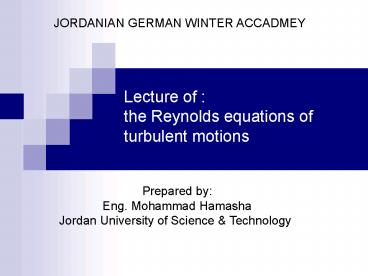Lecture of : the Reynolds equations of turbulent motions - PowerPoint PPT Presentation
1 / 20
Title:
Lecture of : the Reynolds equations of turbulent motions
Description:
... has used the concept of time averaging. ... The components of are related not only to fluid physical. properties but also to local flow conditions (velocity, ... – PowerPoint PPT presentation
Number of Views:511
Avg rating:3.0/5.0
Title: Lecture of : the Reynolds equations of turbulent motions
1
Lecture of the Reynolds equations of turbulent
motions
JORDANIAN GERMAN WINTER ACCADMEY
Prepared by Eng. Mohammad Hamasha Jordan
University of Science Technology
2
- Most of the research on turbulent flow analysis
is the - past century has used the concept of time
averaging. - Applying time averaging to the basic equations
of - motion yield Reynolds equations.
- Reynolds equations involve both mean and
- fluctuating quantities.
- Reynolds equations attempt to model fluctuating
- terms by relating them to the mean properties
or - gradients.
- Reynolds equations form the basis of the most
- engineering analyses of turbulent flow.
3
- assume
- Fluid is in a randomly unsteady turbulent state.
- Worked with the time-averaged or mean equations
- of motion.
- So any variable is resolve into mean value
plus - fluctuating value
- Where T is large compared to relevant period of
- fluctuation.
4
- Itself may vary slowly with time as the
- following figure
fig 1
5
- Lets assume the turbulent flow is incompressible
flow with constant transport properties with
significant fluctuations in velocity, pressure
and temperature. - The variables will be formed as following
equ.. 1
- From the basic integral Equation
6
- incompressible continuity equation
equ...2
- Substitute in u, v, w from equ 1 and take the
time average of entire equation
equ .3
- This is Reynolds-averaged basic differential
equation for turbulent mean - continuity.
- Subtract equ 3 from equ 2 but do not take time
average, this gives
equ4
7
- equations 3 and 4 does not valid for fluid with
density fluctuating - ( compressible fluid ).
- Now use non linear Navier-Stokes equation
equ5
- Convective- acceleration term
equ.6
8
- substitute equ 2 in to equ 5
equ..7
- the momentum equation is complicated by new term
involving - the turbulent inertia tensor .
- This new term is never negligible in any
turbulent flow and is the - source of our analytic difficulties.
- time-averaging procedure has introduced nine new
variables (the tensor components) which can
be defined only through (unavailable) knowledge
of the detailed turbulent structure.
9
- The components of are related not only
to fluid physical - properties but also to local flow conditions
(velocity, - geometry, surface roughness, and upstream
history).
- there is no further physical laws are available
to resolve this - dilemma.
- Some empirical approaches have been quite
successful, - though rather thinly formulated from
nonrigorous postulates.
10
- A slight amount of illumination is thrown upon
Eq. 7 if it is - rearranged to display the turbulent inertia
terms as if they - were stresses, which of course they are not.
Thus we write
equ..8
- This is Reynolds-averaged basic differential
equation for turbulent mean - momentum.
equ..9
Turbulent
Laminar
- mathematically, then, the turbulent inertia terms
behave as if the - total stress on the system were composed of
the Newtonian - Viscous Stresses plus an additional or
apparent turbulent- - stress tensor .
- is called turbulent shear.
11
- Now consider the energy equation (first law of
thermodynamics) - for incompressible flow with constant
properties
equ..10
- Taking the time average, we obtain the
mean-energy equation
equ..11
- This is Reynolds-averaged basic differential
equation for turbulent mean - thermal energy.
equ..12
equ..13
Turbulent
Laminar
12
- By analogy with our rearrangement of the momentum
equation, we - have collected conduction and turbulent
convection terms into a - sort of total-heat-flux vector qi which
includes molecular flux plus - the turbulent flux .
- The total-dissipation term is obviously
complex in the general - case. In two-dimensional turbulent-boundary-la
yer flow (the most - common situation), the dissipation reduces
approximately to
equ..14
- Reynolds equations can not be achieve without
additional relation or - empirical modeling ideas
13
The Turbulence Kinetic-Energy Equations
14
- Many attempts have been made to add "turbulence
conservation - relations to the time-averaged continuity,
momentum, and energy - equations.
- the most obvious single addition would be a
relation for the - turbulence kinetic energy K of the
fluctuations, defined by
equ.15
15
- A conservation relation for K can be derived by
forming the mechanical energy - equation, i.e., the clot product of u and the
ith momentum equation. then, we - subtract the instantaneous mechanical energy
equation from its time-averaged - value. The result is the turbulence
kinetic-energy relation for an incompressible - fluid
equ.16
16
17
The Reynolds stress equation
18
II
III
I
IV
V
19
- Here the roman numerals denote (I) rate of change
of Reynolds stress, - (II) generation of stress, (III) dissipation,
(IV) pressure strain effects, - and (V) diffusion of Reynolds stress.
20
Thank you































